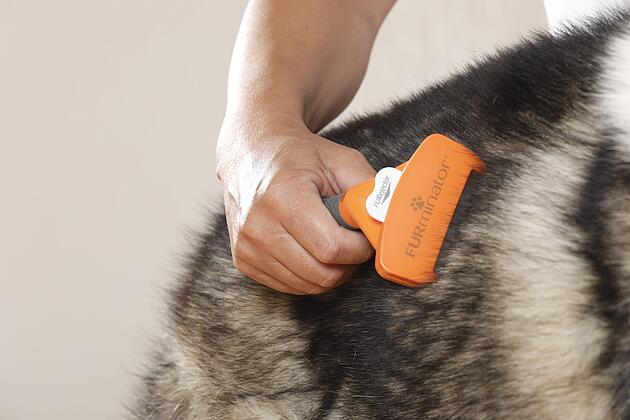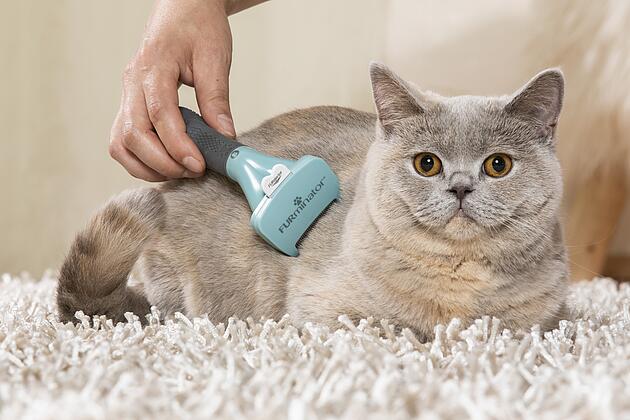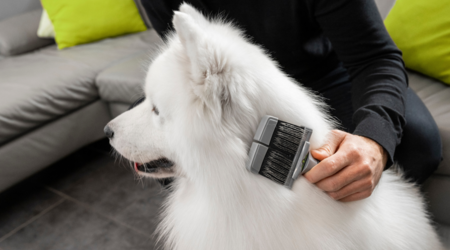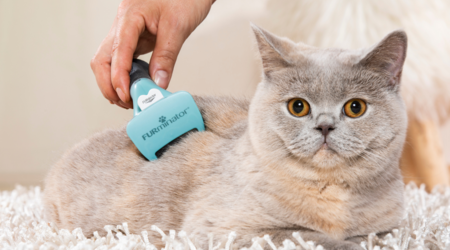Hairy times: No shedding season without FURminator
Every year, pet owners have plenty to do in spring and autumn. Due to the changes in temperature, their furry friends start to shed and lose their undercoat. It’s a completely natural and necessary process. Read on to find out why regular grooming is so important in spring and autumn.
You’re not the only one who has a summer and winter wardrobe; your pet also adapts to the changing seasons and the prevailing temperatures at the time. In autumn, pets swap their light summer coat for a warm winter one. In spring, on the other hand, they exchange their thick coat for a thinner version.
Shedding isn’t only triggered by the onset of cold weather, for example, but also by the changing amount of daylight. Together, these factors initiate hormonal changes that have an impact on their fur. It takes around six to eight weeks for most animals to shed their coat, which unfortunately leaves behind obvious traces for you as a pet owner.

DeShedding is worthwhile
Depending on the breed and type of your pet, you may end up with tufts of hair all over your floor or stuck to your clothes. Weekly ‘deShedding’ is therefore particularly worthwhile in spring and autumn for the following reasons:
• You don’t have to vacuum the floor and brush hair off your clothes every day.
• You prevent your pet’s fur from becoming tangled.
• You support the shedding and therefore speed up the process.
• Your pet’s fur looks shiny and in great condition.
• You automatically watch out for any unusual spots or changes and therefore keep a good eye on your pet’s health.
• You avoid skin irritations and reduce allergens.
• Grooming helps to strengthen your bond with your pet.

Grooming dogs
All dogs shed their coat, even if it’s more visible with long-haired breeds such as Maltese dogs, Afghan Hounds or Border Collies. At around 6-8 months of age, puppies begin to shed their puppy coat and transition into their adult coat. This adult coat is typically thicker and coarser which means proper grooming is necessary to keep shedding to a minimum. As your dog ages, you may notice they shed more than usual, which is normal as their hair roots become weaker. However, the amount of undercoat they have in the first place depends largely on the breed. Dogs that are adapted to a cold climate (Huskies being a prime example), have a much thicker undercoat than a Jack Russell Terrier. At the same time, different-sized breeds have different deSHEDDING tool requirements. We, therefore, offer a selection of tools that you can adapt specifically to your dogs’ size (from XS to XL) and hair length. Find out which product is best for your pet here

Grooming cats
Cats like to groom themselves, and their rough tongue is particularly helpful for removing loose hair from their coat. They tend to swallow this hair before regurgitating it back out again later in the form of hairballs. But, this can get out of hand during shedding season. Therefore, some cats need grooming assistance during this time. By using the FURminator® Undercoat deSHEDDING Tool, you can strengthen the bond with your furry friend because the action of the undercoat tool can be like having a little massage. At the same time, deshedding helps to remove loose hair and undercoat and thereby helps to keep your home and clothes clean. These are important for grooming, as they make sure that the top coat remains water-resistant. Regardless whether you have a short-haired or long-haired cat, you can substantially reduce hairballs with the appropriate FURminator® Undercoat deSHEDDING Tool.



